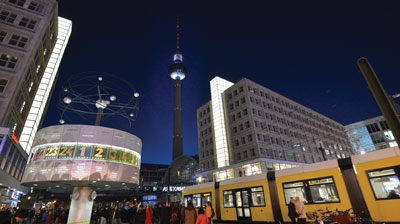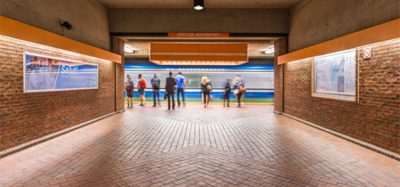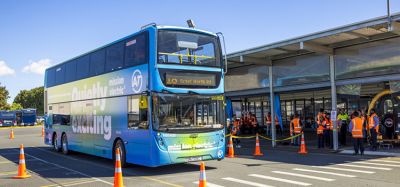Future-proofing public transport in the growing city of Berlin
- Like
- Digg
- Del
- Tumblr
- VKontakte
- Buffer
- Love This
- Odnoklassniki
- Meneame
- Blogger
- Amazon
- Yahoo Mail
- Gmail
- AOL
- Newsvine
- HackerNews
- Evernote
- MySpace
- Mail.ru
- Viadeo
- Line
- Comments
- Yummly
- SMS
- Viber
- Telegram
- Subscribe
- Skype
- Facebook Messenger
- Kakao
- LiveJournal
- Yammer
- Edgar
- Fintel
- Mix
- Instapaper
- Copy Link
Posted: 12 March 2015 | Dr Sigrid Evelyn Nikutta, BVG
Chairwoman of the Management Board and Chief Executive Officer of the BVG, Dr Sigrid Evelyn Nikutta, takes a look at current challenges and new opportunities on the horizon for the operator to ensure that public transport in the future will be Berlin’s number one mode of travel…


Just a few months ago, in November 2014, Berlin was once again at the centre of attention. Twenty-five years after the fall of the Berlin Wall, numerous events were hosted throughout the city to commemorate both the momentous and more minor stories that unfolded here in the autumn of 1989. As part of the anniversary, the Berliner Verkehrsbetriebe (BVG) published a book1 about its role in the days, weeks and months following the events of 9 November 1989.
The book tells the story of how 100 BVG bus drivers voluntarily showed up for work on their day off upon hearing that the borders had been opened; how new lines were created at an astonishing rate and drivers and buses from other cities came to Berlin to support public transport in the newly reunited city; how all of what were colloquially known as ‘Geisterbahnhöfe’ (‘ghost stations’) in East Berlin, through which underground trains from the West had passed without stopping for years, were reopened by 1990. In a nutshell, it relates how West Berlin’s BVG and East Berlin’s BVB helped the city and its people join hands by immediately providing mobility across the former border, and how both companies eventually grew together (again) themselves.
Today: providing public transport for almost a billion passengers a year
A quarter of a century later, Berlin is a vibrant and thriving city that has countless new stories to tell every day. People from all over the world come to the German capital to study, work and live or simply to spend some days or weeks enjoying its arts, culture, history and nightlife. Berlin’s population currently stands at approximately 3.4 million and is expected to grow to almost 3.6 million by 2030. Adding to this, thousands of people commute from the surrounding state of Brandenburg on weekdays, and in 2013 alone, Berlin welcomed more than 11 million tourists. It is the Berliner Verkehrsbetriebe (BVG), Germany’s largest local public transport operator, along with S-Bahn Berlin GmbH (a subsidiary of Deutsche Bahn AG), the operator of Berlin’s urban train network, that provide excellent, low-cost public transport to all of these groups.
The BVG, which is owned by the State of Berlin, currently operates 10 underground lines and 22 tram lines, 195 bus routes and five ferries. In 2013, 947.3 million passengers used this extensive public transport network to get around the German capital. Passenger numbers have been rising steadily – by around 60 million in 10 years – and the BVG is working hard to keep this trend going, with the aim of achieving one billion passenger trips per year by 2020.
In 2014 alone, services were increased on a total of 39 bus routes, tram and underground lines – a response to the changing habits and working patterns of the BVG’s passengers and the continuing growth of Berlin’s population. On a daily basis, around 250,000 passengers profit from these improvements, which were commissioned and financed by the Senate of Berlin. For example, intervals between trains on a number of underground lines were shortened in the late afternoon and the evening, as working hours at many of Berlin’s young businesses now tend to end later than in the traditional ‘nine to five’ setting. Underground services in the late evening (until after midnight) have also been stepped up to respond to the growing desire for integrated night-time mobility.
Sustainable city: the BVG’s role in a greener Berlin
As of 2008 – the last time the modal split was recorded – 26% of all inner-city journeys in Berlin were made on public transport, against 31% made with private, motorised vehicles2. In order for the city to grow in an ecologically sound manner and ensure a high quality of life in the future, the relative share of public transport needs to be increased. Not only does it counter the lack of space Berlin, like many other cities, is faced with, but as underground trains and trams are electrified, they can also be run on renewable energy sources as opposed to fossil fuels. Today, four of the BVG’s ferries are solar-powered; and beginning in summer 2015, the BVG will be the first operator in a European capital to test a complete inner-city line with e-buses that are charged wirelessly: route 204 between S Südkreuz and S+U Zoologischer Garten.
The 947 million passenger trips taken on the BVG’s trains, trams and buses in 2013 replaced 790 million individual trips by car, reducing carbon dioxide emissions in Berlin by 400,000 tonnes. The figures speak for themselves: public transport’s share is an important factor when it comes to protecting our climate. And the BVG takes pride in playing a major role in Berlin’s exemplary efforts to become a sustainable city: just recently, Berlin was ranked number one out of all 16 states in a study on sustainable mobility in Germany3.
Fortunately, the privately owned car already seems to be retreating as a status symbol for the young, urban generation – even in an allegedly ‘car-crazy’ country such as Germany. Now is therefore the time for the BVG to cement its role as the backbone of Berlin’s inner-city mobility, ideally coupled with other green means of transport. These include traditional modes such as walking and cycling, new forms of e-mobility or car club solutions.
Infrastructure projects, part I: ‘Lückenschluss U5’
Of all the BVG’s current infrastructure projects, the ‘Lückenschluss U5’ (‘closing of the U5 gap’) is by far the most significant. Connecting the U5 (at present U Hönow to S+U Alexanderplatz) with the youngest and shortest of Berlin’s underground lines, the U55 (S+U Brandenburger Tor to S+U Hauptbahnhof), will create a ‘new’ U5 with a total length of 22km. Once finished, the U5 will be Berlin’s second longest underground line after the U7, which is by far the longest with a length of 31.8km.
Underground construction works began in 2012. Three new stations are under construction between S+U Brandenburger Tor and S+U Alexanderplatz: Unter den Linden, Museumsinsel and Berliner Rathaus. The 700-tonne tunnel boring machine, aptly named ‘Bärlinde’4 in a public vote, completed digging the first of two tunnels measuring 1.6km in summer 2014. Although extremely difficult geological conditions have caused minor setbacks and delays, the first underground trains from U Hönow are expected to reach S+U Hauptbahnhof in 2020.
The new U5 will open up new transport options for up to 155,000 passengers a day. Those living in the Eastern districts will have a direct connection to Berlin’s historic centre, the government district and Berlin’s central station, the most important transfer hub for long-distance train travel. Likewise, millions of visitors will profit each year as central tourist attractions are finally connected to the underground network. Unter den Linden station will also serve as an interchange between the U5 and U6, further enhancing the underground grid in central Berlin.
Infrastructure projects, part II: tram connection to Berlin central station
While there are a few years left until the connection of the U5 and U55 is completed, another major infrastructure project is currently in its final phase. Since December 2014, the M5 – formerly terminating at S Hackescher Markt – is the first of three tram lines to bring passengers to Berlin Hauptbahnhof (central station). The extension of the M8 and M10 from their current terminus of S Nordbahnhof to S+U Hauptbahnhof will follow later in 2015. The extension of the M10 will be of particular value, as densely populated areas in Prenzlauer Berg and Friedrichshain will gain a direct, fast connection to Berlin’s most important mainline station. Once all three tram lines are connected to S+U Hauptbahnhof, up to 20,000 passengers will use the new 2.2km stretch of tram tracks on a daily basis.
In a way, the tram connection to Berlin central station is yet another step towards correcting a historical mistake made in West Berlin during the years in which the city was divided. While the pre-WW2 tram network was at least partially kept in place in East Berlin, traffic in West Berlin was – so to speak – ‘Americanised’. Aiming at a ‘car-friendly’ environment, trams were abolished, but today, it is obvious that relying on inner-city private, motorised traffic is a concept of the past. The BVG already operates the fourth most extensive tram network worldwide. By gradually bringing tram services back to the western districts, the BVG will make Berlin’s public transport even more reliable, comfortable and sustainable.
Infrastructure projects, part III: making public transport accessible
What may be no more than additional comfort to some is a necessity to others: accessibility to public transport. The BVG therefore constantly works to make its services accessible and reliable for passengers in wheelchairs and those with reduced mobility. All of the BVG’s 1,300 buses are already low-entry, with the new ‘Scania Citywide LFA’ models that entered service in late-2014 offering dedicated space for two wheelchairs as well as a pram at any one time. In the BVG’s tram fleet, the last remaining ‘Tatra’ model trains, which are not suited for wheelchair users, will be replaced by 2017.
Without doubt, one of the biggest challenges in this regard is to offer step-free access to Berlin’s underground system. At the end of 2014, 108 of the BVG’s 173 underground stations were accessible via lifts (99) or ramps (nine). Although building lifts into existing underground stations is a difficult, time-consuming process, the BVG is confident that it will finish equipping all of them with lifts by the year 2020. Tactile guiding systems for the blind or visually impaired, currently installed in 115 underground stations, will also be standard by then.
Those who matter most: passenger participation and information, digital services
Of course, new ‘hardware’ in the form of new lines and vehicles is not sufficient to keep customer satisfaction levels high or even raise them – which, in turn, is essential for strengthening public transport’s role in the ever-changing city of Berlin. It is equally important that customers participate in decision-making processes. The BVG therefore maintains constant dialogue with these key stakeholders and responds to their needs and concerns. The BVG customer council, a committee of 30 passengers appointed for two years, is the most prominent partner in this dialogue.
All customer groups are represented on the council – from teenagers to pensioners, including passengers with reduced mobility. Of course, different groups have different expectations of public transport: some value frequent services, good connections and electronic information systems, while others want clear directions and user-friendly ticket machines. Young party-goers are most concerned about night services, families desire space for their prams and senior citizens might want information to be printed in a larger font. The BVG is thankful for the work the council members put in (on a voluntary basis!) and uses the inspiration and information received to further improve its services.
On a different note, as far as providing information and service to passengers is concerned, ongoing digitalisation has opened up a whole range of new possibilities which the BVG gladly embraces. In August 2014, the company website5 was given a full makeover. Since then, visitors have benefitted from a more intuitive navigation and a design that responds according to the type of device used. The ‘BVG FahrInfo Plus’ app, available free-of-charge for iOS and Android devices and already downloaded one million times, not only allows passengers to carry all relevant travel information in their pockets. It also serves as a mobile ticket machine and is used for 1,500 to 2,000 ticket purchases every day.
Joining forces: making Berlin’s public transport even more secure
As is well-known, a subject that is addressed frequently with regard to public transport is security. Even though statistics show that crime is less prevalent in public transport spaces than in other public areas, the BVG takes these worries and concerns very seriously.
In 2011, the BVG, the Berlin police and the Senate of Berlin established an array of measures to further improve security in the BVG’s facilities. For example, video surveillance at 20 underground stations was stepped up and storage of CCTV footage was extended from 24 to 48 hours. The BVG’s central security control, which is operated around the clock, now has a Police Officer present at all times who in turn has a direct line to the Berlin police’s central control room. The BVG and Berlin police have both increased their personnel and intensified their partnership: while there were 998 joint preventative operations in underground trains and stations in 2011, the figure had risen to 1,371 in 2013.
In autumn 2013, further cooperation commenced – this time between the BVG’s own security forces and those of Deutsche Bahn. Since then, joint patrols have made the presence of security personnel even more visible. Deutsche Bahn/S-Bahn Berlin and the BVG now also grant each other domiciliary rights in their respective facilities, joining up security operations at large stations where urban train and underground services meet (e.g. S+U Alexanderplatz).
The measures taken have proven to be highly effective: between 2008 and 2013, the number of crimes registered in BVG facilities dropped by more than 10% – despite rising passenger numbers. At the same time, physical assaults fell by 23%. The costs for repairing damage caused by graffiti sprayers and other vandals were cut even more drastically: from €9.7 million in 2008 to €4 million in 2013. And surveys show that the passengers themselves continually feel more secure: between 2013 and 2014, for example, underground customers’ ratings went up in all security-related categories.
Outlook: all set for a challenging future
Historically, Berlin has been known worldwide to have superb public transport – tram services will see their 150th anniversary later in 2015. However, considering the demographic and ecological challenges the city is faced with, it is of utmost importance not to rest on what has been accomplished so far.
Besides those infrastructure projects for which construction works are currently in progress, further possible connections are at different stages of planning. This includes, for example, additional services to Ostkreuz – an important hub for regional travel – or a westward extension of tram services from S+U Hauptbahnhof to U Turmstraße. As far as bus infrastructure is concerned, a major issue that the BVG has identified as pressing is the relative scarceness of bus boarders in Berlin and the effect this has on service speeds and accessibility for those with reduced mobility. With regards to the vehicle fleet, gradual investment is required to reduce the average age of the BVG’s 1,238 underground cars, currently standing at around 29 years for the small profile (U1-U4) and 26 years for the large profile (U5-U9) trains. The first ‘IK’ trains – the newest model for the small profile – will be tested in 2015.
With these and other new challenges on the horizon, the BVG is ready and willing to continue making the greatest of efforts while working closely together with all of its partners – be they passengers, government, technology companies or scientific institutions – to ensure that in the future, public transport will be Berlin’s number one mode of travel. Twenty-five years after reunification, the German capital remains a polycentric city. It is the BVG that connects its ‘Kieze’ and their residents and thus truly makes Berlin one. And through its significant contributions to the city’s ambitious climate targets, the BVG stands out as a key player in making Berlin a greener, more attractive place to live.
References
- Thomas Rietig: Mit Bus und Bahn durch die Mauer. Die BVG in der Zeit der deutschen Vereinigung 1989-1992 (ISBN 978-3-95462-405-8)
- Walking: 30%, cycling: 13%
- http://www.allianz-pro-schiene.de/eng/press/all-press-releases-1/2013/transportation-is-not-a-natural-phenomenon-its-hard-work/
- A portmanteau of the German word for bear (Berlin’s heraldic animal) and ‘Unter den Linden’, the famous boulevard under which large parts of the new tunnels are being dug
- BVG.de
Biography
After studying psychology at university, Dr Sigrid Evelyn Nikutta initially worked at a medium-sized company before joining Deutsche Bahn AG in 1996, where she was most recently Director of Production Freight Train Services at DB Schenker Rail and Director of Production at the Polish Schenker subsidiary. On 1 October 2010, she entered office as Chairwoman of the Management Board and Chief Executive Officer of Berlin’s public transport company, the BVG.
Related topics
Business Models, Infrastructure & Urban Planning, Public Transport
Issue
Issue 1 2015
Related cities
Germany
Related organisations
Berliner Verkehrsbetriebe (BVG)








